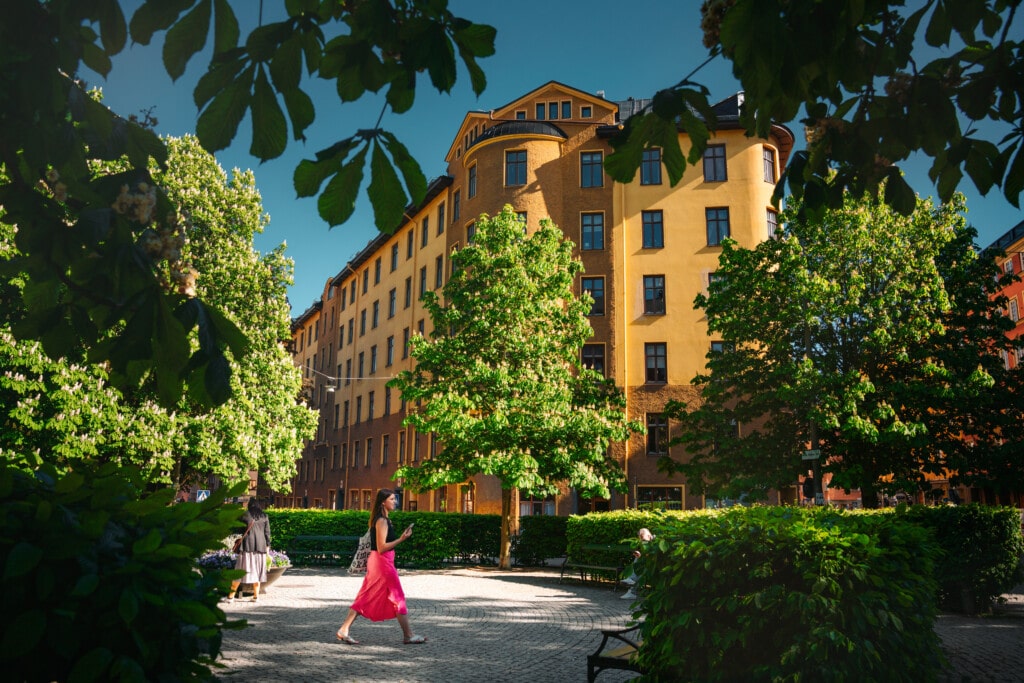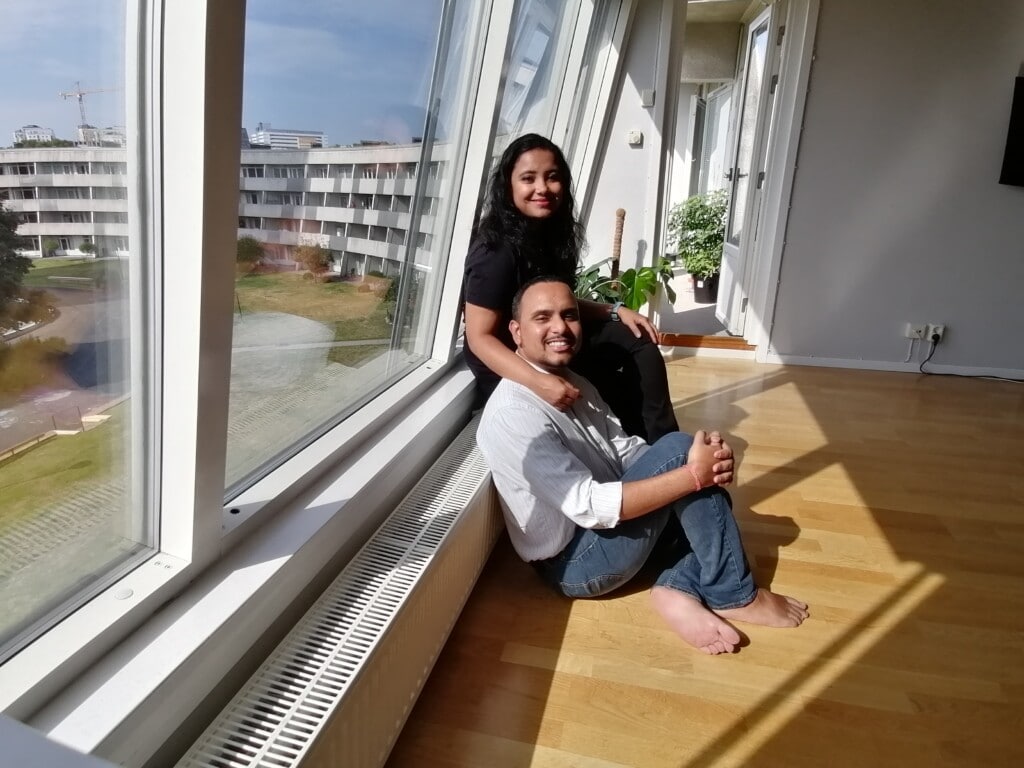

Finding accommodation in Stockholm as an expatriate: a brief exploration
Finding accommodation in Stockholm as an expatriate: a brief exploration
A city in flux
Probably the most distinctive feature of the Stockholm cityscape that immediately catches one’s attention, is the presence of high tower cranes and busy construction scaffoldings interspersed almost all over the city. These seem to punctuate your view no matter which neighborhood you are in – a testament to the capital of Sweden being in a constant state of flux – building, renovating and morphing on a regular basis.
This is a reflection of the entrepreneurial ethos of Stockholm, which is characterized by its blossoming ecosystem of start-ups and multinational entities. This dynamic environment, coupled with the welfare policies of the government, has made Stockholm an expatriate’s Shangri-La. Over the years, this has led to an influx of international talent, who now occupy a multitude of ranks in the workforce and make up a significant part of the city’s burgeoning population. Indeed, Stockholm is one of the fastest growing cities of Europe in terms of its population – a vibrant 1.6 million people, 15% of whom are foreign-born, which is the highest of any Scandinavian city.
The fly in the ointment
It naturally follows that this spurt in the population would be supported by a proportionate investment in the residential infrastructure of the city. However, this is where Stockholm falls dismally short of expectations, as we found out in June 2019. The lease of our apartment was pre-terminated by our landlord and we had to look for new lodgings.
Between my wife and I, we had stayed in four different cities and were used to intermittent shifting – how difficult could it be, we figured? We were in for an unpleasant surprise. The house-hunting turned out to be an arduous process that panned over two months in the course of which we went through a range of unsavory experiences – from being quoted astronomical rents for tiny spaces in basements and attics, to being rejected numerous times after apartment viewings, to almost being scammed, and coming close to losing our minds after endless hours of browsing through and applying for apartments on various property sites.
I later read that Swedes, with their ironical sense of humor, had even coined a term for this feverish exercise, a portmanteau word – hemnetknarka – Hemnet, a property site and knarka, ‘take drugs’, which quite precisely conveys the toll that the pursuit of apartments in Stockholm exacts on one’s mental health! When we finally landed an apartment and thanked our stars for small mercies, I decided to delve deeper into the housing situation in Stockholm and find out what went so wrong.

The housing crisis
I learnt that the bostadsbrist or ‘the housing shortage’ in Sweden (Stockholm, Gothenburg and Malmö being the most populous and therefore the worst-affected cities) owes its genesis to a financial crisis in the early 1990s, which among other things, caused a sharp downturn in the housing construction industry. During this period of economic turmoil, state subsidies to public housing companies were significantly reduced, while land prices and construction costs went up. The Swedish rental market regulations made it less profitable for construction companies to build residential accommodation.
Ever since then, even with construction picking up pace later on, the number of available residences has never been able to catch up with the concurrent growth in the population and the consequent demand thereof. This disparity is the most acute in the Stockholm city area.
Data from the National Board of Housing, Building and Planning (Boverket) also reveal that in 2021, 207 out of 288 municipalities in Sweden reported a housing deficit, especially of first-hand rental accommodations (hyresrätter), the prices for which are determined through negotiations between landlord and tenant representatives. But these are almost impossible to come by, with infamous wait periods that stretch beyond ten years on an average, and often even more! This leaves most expatriates grappling with second-hand rental leases which are competitively priced and much more expensive, especially for those staying within the Stockholm city area.
Sweden’s housing crisis has not only been an impediment to societal integration, having a disproportionate impact on economically-vulnerable immigrant groups and students, it has also dented the business-friendly image of Stockholm, with the International Monetary Fund (IMF) urging the government to deregulate the housing market, and many corporates, most notably the founders of Spotify decrying how the lack of affordable rental properties in the city has adversely affected their desire to attract international talent.
Finding accommodation and things to be mindful of
However, the Swedish government is working towards turning this situation around. Along with the proposed phasing out of rent regulations on new properties and stricter measures against overcharging for sublets, the government has also earmarked an investment volume of 60.7 billion Euros to construct 400,000 units of housing. So, despair not, fellow expatriates, for there lies hope ahead! Having gone through this process myself, here are a few tips that might help you out in your house hunt:
1. Sign up for that bostadskö anyway
There is no changing the fact that the wait periods for first-hand contracts are long. So, while you are looking for a more probable second-hand rental, you might as well choose to register for an allotment at the Stockholm Housing Agency (Bostadsförmedlingen) for an annual fee of 200 SEK.
You don’t stand to lose anything; instead, you never know if you might luck out! A pragmatic thing to do would be to also keep an eye out for rental opportunities in upcoming properties in suburban areas such as Vega, Väsby, Nacka, Brandbergen, Solberga and others. The registration for these is usually free, but you would need a Swedish personal number (personnummer) for it.
2. Create detailed profiles on multiple rental sites
Qasa is a great starting point for internationals, primarily because the website and the property descriptions are in English, and you can create a profile even if you don’t have a Swedish personnummer. You can choose to draw up the contract in English as well. Payments are made via the organization only after you have moved in, which makes the process entirely safe.
Other than Qasa, the most prolific online marketplace is Blocket – this website has the most number of rental listings.
Bostaddirekt, Samtrygg, Myplejs and The Local’s rental page are helpful too.
Create profiles on all these websites and check them regularly to maximize your chances of getting an apartment. Include details which will convey your credibility and trustworthiness, such as – a friendly profile photograph, details of your job, links to your professional profiles, where you are from, references from employers and previous landlords, the number of people planning to stay at the apartment, your earliest availability to move in. Also include other ancillary information pertinent to particular advertisements such as, if you are a smoker, if you have a vehicle or a pet. Lastly, clearly state your maximum budget, preferred area of the city, the required size of the apartment, necessary amenities (microwave, dishwasher, grill, laundry etc.), whether you need a furnished apartment or not, and so on.
3. Make haste!
Remember that the moment a rental advertisement goes up on any of these websites, the property owners receive hundreds of applications within the first hour. The sooner you apply and lock in a viewing (visning) of the apartment, the better your chances are.
In order to do this, keep a carefully worded email template ready, that will help you stand out from the crowd. Sound earnest and cordial in the email, and introduce yourself by providing personal and professional details, since when have you been a resident of Sweden, your reasons for being here, and why you are interested in the apartment.
If the advertisement is in Swedish, it is more courteous to apply in Swedish as well, in which case you can either use an online language translation tool, or perhaps seek help from a friend or a colleague who speaks Swedish.
4. Suburbs ahoy!
This ties in with the first point about looking out for available vacancies in the suburban neighborhoods of Stockholm. It’s greener and calmer in these parts, with the rental market less competitive, which means your chances of finding an affordable apartment increase. The excellent connectivity of the outskirts to the main city ensures a short, hassle-free commute. Apart from the usual websites, the rental service, Homii specializes in suburban properties.
5. Beware of scams
Rental scams continue to plague the housing market of Stockholm, and you need to watch out for red flags in your dealings with potential property owners. Refrain from any monetary transaction before you have viewed the property and talked to the owner in person, and not just corresponded over the phone or by email.
Always remember to confirm the identity of the owner by looking them up on LinkedIn, Facebook, or Swedish residential databases such as Hitta and Eniro. Legitimate house-owners should be forthcoming with the details of their profession along with workplace references, and have no issues in furnishing proofs of identity. Trust your instincts if anything feels out of place.
6. Know your rights as a tenant
Lastly, some familiarity with Swedish rental laws, your rights as a second-hand tenant, and knowledge of organizations like the Swedish tenants’ union (Hyresgästföreningen) which protect those rights, will certainly be of help in negotiating with any situation arising during your rental tenure.
Concluding remarks
The state mortgage provider – SBAB Bank – has recently predicted that at the present rate of construction across Sweden, both in the main cities and the suburbs, the housing shortage could be resolved by 2027.
My wife and I have been living in a first-hand rental for a year and a half, after being in the queue for almost three years. It’s been a long waiting period, but when I see the remarkable dip in our expenses now, I feel it’s been totally worth the wait!

About the author
Anirban Dey is a writer/communicator at Stockholm Academic Forum, and a SDCN Management Team member. He has previously worked in the field of pedagogy and educational publishing.
This article was originally published in August 2020, and was updated in October 2021.
Last updated 2021/10/14
A city in flux
Probably the most distinctive feature of the Stockholm cityscape that immediately catches one’s attention, is the presence of high tower cranes and busy construction scaffoldings interspersed almost all over the city. These seem to punctuate your view no matter which neighborhood you are in – a testament to the capital of Sweden being in a constant state of flux – building, renovating and morphing on a regular basis.
This is a reflection of the entrepreneurial ethos of Stockholm, which is characterized by its blossoming ecosystem of start-ups and multinational entities. This dynamic environment, coupled with the welfare policies of the government, has made Stockholm an expatriate’s Shangri-La. Over the years, this has led to an influx of international talent, who now occupy a multitude of ranks in the workforce and make up a significant part of the city’s burgeoning population. Indeed, Stockholm is one of the fastest growing cities of Europe in terms of its population – a vibrant 1.6 million people, 15% of whom are foreign-born, which is the highest of any Scandinavian city.
The fly in the ointment
It naturally follows that this spurt in the population would be supported by a proportionate investment in the residential infrastructure of the city. However, this is where Stockholm falls dismally short of expectations, as we found out in June 2019. The lease of our apartment was pre-terminated by our landlord and we had to look for new lodgings.
Between my wife and I, we had stayed in four different cities and were used to intermittent shifting – how difficult could it be, we figured? We were in for an unpleasant surprise. The house-hunting turned out to be an arduous process that panned over two months in the course of which we went through a range of unsavory experiences – from being quoted astronomical rents for tiny spaces in basements and attics, to being rejected numerous times after apartment viewings, to almost being scammed, and coming close to losing our minds after endless hours of browsing through and applying for apartments on various property sites.
I later read that Swedes, with their ironical sense of humor, had even coined a term for this feverish exercise, a portmanteau word – hemnetknarka – Hemnet, a property site and knarka, ‘take drugs’, which quite precisely conveys the toll that the pursuit of apartments in Stockholm exacts on one’s mental health! When we finally landed an apartment and thanked our stars for small mercies, I decided to delve deeper into the housing situation in Stockholm and find out what went so wrong.

The housing crisis
I learnt that the bostadsbrist or ‘the housing shortage’ in Sweden (Stockholm, Gothenburg and Malmö being the most populous and therefore the worst-affected cities) owes its genesis to a financial crisis in the early 1990s, which among other things, caused a sharp downturn in the housing construction industry. During this period of economic turmoil, state subsidies to public housing companies were significantly reduced, while land prices and construction costs went up. The Swedish rental market regulations made it less profitable for construction companies to build residential accommodation.
Ever since then, even with construction picking up pace later on, the number of available residences has never been able to catch up with the concurrent growth in the population and the consequent demand thereof. This disparity is the most acute in the Stockholm city area.
Data from the National Board of Housing, Building and Planning (Boverket) also reveal that in 2021, 207 out of 288 municipalities in Sweden reported a housing deficit, especially of first-hand rental accommodations (hyresrätter), the prices for which are determined through negotiations between landlord and tenant representatives. But these are almost impossible to come by, with infamous wait periods that stretch beyond ten years on an average, and often even more! This leaves most expatriates grappling with second-hand rental leases which are competitively priced and much more expensive, especially for those staying within the Stockholm city area.
Sweden’s housing crisis has not only been an impediment to societal integration, having a disproportionate impact on economically-vulnerable immigrant groups and students, it has also dented the business-friendly image of Stockholm, with the International Monetary Fund (IMF) urging the government to deregulate the housing market, and many corporates, most notably the founders of Spotify decrying how the lack of affordable rental properties in the city has adversely affected their desire to attract international talent.
Finding accommodation and things to be mindful of
However, the Swedish government is working towards turning this situation around. Along with the proposed phasing out of rent regulations on new properties and stricter measures against overcharging for sublets, the government has also earmarked an investment volume of 60.7 billion Euros to construct 400,000 units of housing. So, despair not, fellow expatriates, for there lies hope ahead! Having gone through this process myself, here are a few tips that might help you out in your house hunt:
1. Sign up for that bostadskö anyway
There is no changing the fact that the wait periods for first-hand contracts are long. So, while you are looking for a more probable second-hand rental, you might as well choose to register for an allotment at the Stockholm Housing Agency (Bostadsförmedlingen) for an annual fee of 200 SEK.
You don’t stand to lose anything; instead, you never know if you might luck out! A pragmatic thing to do would be to also keep an eye out for rental opportunities in upcoming properties in suburban areas such as Vega, Väsby, Nacka, Brandbergen, Solberga and others. The registration for these is usually free, but you would need a Swedish personal number (personnummer) for it.
2. Create detailed profiles on multiple rental sites
Qasa is a great starting point for internationals, primarily because the website and the property descriptions are in English, and you can create a profile even if you don’t have a Swedish personnummer. You can choose to draw up the contract in English as well. Payments are made via the organization only after you have moved in, which makes the process entirely safe.
Other than Qasa, the most prolific online marketplace is Blocket – this website has the most number of rental listings.
Bostaddirekt, Samtrygg, Myplejs and The Local’s rental page are helpful too.
Create profiles on all these websites and check them regularly to maximize your chances of getting an apartment. Include details which will convey your credibility and trustworthiness, such as – a friendly profile photograph, details of your job, links to your professional profiles, where you are from, references from employers and previous landlords, the number of people planning to stay at the apartment, your earliest availability to move in. Also include other ancillary information pertinent to particular advertisements such as, if you are a smoker, if you have a vehicle or a pet. Lastly, clearly state your maximum budget, preferred area of the city, the required size of the apartment, necessary amenities (microwave, dishwasher, grill, laundry etc.), whether you need a furnished apartment or not, and so on.
3. Make haste!
Remember that the moment a rental advertisement goes up on any of these websites, the property owners receive hundreds of applications within the first hour. The sooner you apply and lock in a viewing (visning) of the apartment, the better your chances are.
In order to do this, keep a carefully worded email template ready, that will help you stand out from the crowd. Sound earnest and cordial in the email, and introduce yourself by providing personal and professional details, since when have you been a resident of Sweden, your reasons for being here, and why you are interested in the apartment.
If the advertisement is in Swedish, it is more courteous to apply in Swedish as well, in which case you can either use an online language translation tool, or perhaps seek help from a friend or a colleague who speaks Swedish.
4. Suburbs ahoy!
This ties in with the first point about looking out for available vacancies in the suburban neighborhoods of Stockholm. It’s greener and calmer in these parts, with the rental market less competitive, which means your chances of finding an affordable apartment increase. The excellent connectivity of the outskirts to the main city ensures a short, hassle-free commute. Apart from the usual websites, the rental service, Homii specializes in suburban properties.
5. Beware of scams
Rental scams continue to plague the housing market of Stockholm, and you need to watch out for red flags in your dealings with potential property owners. Refrain from any monetary transaction before you have viewed the property and talked to the owner in person, and not just corresponded over the phone or by email.
Always remember to confirm the identity of the owner by looking them up on LinkedIn, Facebook, or Swedish residential databases such as Hitta and Eniro. Legitimate house-owners should be forthcoming with the details of their profession along with workplace references, and have no issues in furnishing proofs of identity. Trust your instincts if anything feels out of place.
6. Know your rights as a tenant
Lastly, some familiarity with Swedish rental laws, your rights as a second-hand tenant, and knowledge of organizations like the Swedish tenants’ union (Hyresgästföreningen) which protect those rights, will certainly be of help in negotiating with any situation arising during your rental tenure.
Concluding remarks
The state mortgage provider – SBAB Bank – has recently predicted that at the present rate of construction across Sweden, both in the main cities and the suburbs, the housing shortage could be resolved by 2027.
My wife and I have been living in a first-hand rental for a year and a half, after being in the queue for almost three years. It’s been a long waiting period, but when I see the remarkable dip in our expenses now, I feel it’s been totally worth the wait!

About the author
Anirban Dey is a writer/communicator at Stockholm Academic Forum, and a SDCN Management Team member. He has previously worked in the field of pedagogy and educational publishing.
This article was originally published in August 2020, and was updated in October 2021.
Last updated 2021/10/14
